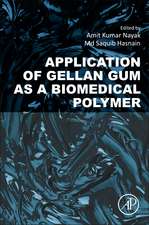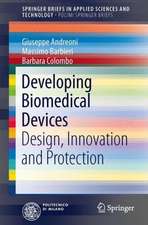Preventive Biomechanics: Optimizing Support Systems for the Human Body in the Lying and Sitting Position
Autor Gerhard Silber, Christophe Thenen Limba Engleză Hardback – 4 aug 2012
| Toate formatele și edițiile | Preț | Express |
|---|---|---|
| Paperback (1) | 783.75 lei 6-8 săpt. | |
| Springer Berlin, Heidelberg – 23 aug 2016 | 783.75 lei 6-8 săpt. | |
| Hardback (1) | 1104.84 lei 6-8 săpt. | |
| Springer Berlin, Heidelberg – 4 aug 2012 | 1104.84 lei 6-8 săpt. |
Preț: 1104.84 lei
Preț vechi: 1162.99 lei
-5% Nou
Puncte Express: 1657
Preț estimativ în valută:
211.41€ • 221.32$ • 174.93£
211.41€ • 221.32$ • 174.93£
Carte tipărită la comandă
Livrare economică 05-19 aprilie
Preluare comenzi: 021 569.72.76
Specificații
ISBN-13: 9783642290022
ISBN-10: 3642290027
Pagini: 386
Ilustrații: XII, 372 p. 301 illus., 208 illus. in color.
Dimensiuni: 155 x 235 x 28 mm
Greutate: 0.68 kg
Ediția:2013
Editura: Springer Berlin, Heidelberg
Colecția Springer
Locul publicării:Berlin, Heidelberg, Germany
ISBN-10: 3642290027
Pagini: 386
Ilustrații: XII, 372 p. 301 illus., 208 illus. in color.
Dimensiuni: 155 x 235 x 28 mm
Greutate: 0.68 kg
Ediția:2013
Editura: Springer Berlin, Heidelberg
Colecția Springer
Locul publicării:Berlin, Heidelberg, Germany
Public țintă
ResearchCuprins
Introduction and Historical Backround.- The New Approach: BOSS-Procedure.- Fundamentals.- Extracorporal Supports.- Human Body Models (BOSS-Models).- Applications-Mechanical Interactions.- Optimization Potential of the Method (Relationship between Perception and Biomechanical Injuries, 'Neuro-Biomechanics').
Notă biografică
Prof. Dr.-Ing. habil. Gerhard Silber, born 1950, obtained his degree in Mechanical Engineering at the Technical University of Applied Sciences Berlin (1975 - 1978) and at the Technical University Berlin (1978 - 1982), where he subsequently received his PhD and habilitated in the field of Continuum Mechanics and Material Theory. From 1989 to 1992 he was employed in the machinery and equipment industry where he was promoted to specialist group leader. In 1992 he was appointed Professor for Engineering Mechanics and Continuum Mechanics at the University of Applied Sciences in Frankfurt/Main. Since 2002 he has been the Managing Director of the Institute for Materials Science (IfM), and since 2005 also Deputy Managing Director of the Center of Biomedical Engineering (Cbme) in Frankfurt/Main. Since 2010 he has been the academic director of the federal state government program “Landes-Offensive zur Entwicklung Wissenschaftlich-ökonomischer Exzellenz” (Loewe) in the state of Hesse (Germany), focussing on Preventive Biomechanics (PräBionik). In 1997 he was awarded the Innovation Award from the sponsoring society of the University of Applied Sciences/Frankfurt. In 2008 he was appointed as a candidate for the German Future Award initiated by the Bmbf and for the Research Award initiated by the state Universities of Applied Sciences.
Dr. rer. med. Christophe Then, born 1971, received his PhD for finite element research in the field of biomechanics of human soft tissue. After several years of employment in the automotive and applied film industry, as a project engineer in the field of finite element analysis, he currently holds the position of research associate inthe Department of Diagnostic and Interventional Radiology of the Goethe-University and in the Institute for Materials Science (IfM) of the University of Applied Sciences in Frankfurt/Main.
Dr. rer. med. Christophe Then, born 1971, received his PhD for finite element research in the field of biomechanics of human soft tissue. After several years of employment in the automotive and applied film industry, as a project engineer in the field of finite element analysis, he currently holds the position of research associate inthe Department of Diagnostic and Interventional Radiology of the Goethe-University and in the Institute for Materials Science (IfM) of the University of Applied Sciences in Frankfurt/Main.
Textul de pe ultima copertă
How can we optimize a bedridden patient’s mattress? How can we make a passenger seat on a long distance flight or ride more comfortable? What qualities should a runner’s shoes have? To objectively address such questions using engineering and scientific methods, adequate virtual human body models for use in computer simulation of loading scenarios are required. The authors have developed a novel method incorporating subject studies, magnetic resonance imaging, 3D-CAD-reconstruction, continuum mechanics, material theory and the finite element method. The focus is laid upon the mechanical in vivo-characterization of human soft tissue, which is indispensable for simulating its mechanical interaction with, for example, medical bedding or automotive and airplane seating systems. Using the examples of arbitrary body support systems, the presented approach provides visual insight into simulated internal mechanical body tissue stress and strain, with the goal of biomechanical optimization of body support systems. This book is intended for engineers, manufacturers and physicians and also provides students with guidance in solving problems related to support system optimization.
Caracteristici
Derivation and description of a new method for biomechanical analysis (BOSS-Procedure) Volume 1 covers Interactions between human body models and extra corporal body supports Includes supplementary material: sn.pub/extras



























